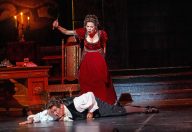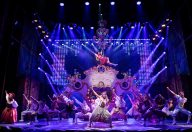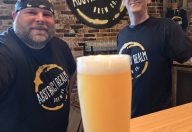‘KAWS + Warhol’ = A Surprising New Art Brew at The Warhol
- Like
- Digg
- Del
- Tumblr
- VKontakte
- Buffer
- Love This
- Odnoklassniki
- Meneame
- Blogger
- Amazon
- Yahoo Mail
- Gmail
- AOL
- Newsvine
- HackerNews
- Evernote
- MySpace
- Mail.ru
- Viadeo
- Line
- Comments
- Yummly
- SMS
- Viber
- Telegram
- Subscribe
- Skype
- Facebook Messenger
- Kakao
- LiveJournal
- Yammer
- Edgar
- Fintel
- Mix
- Instapaper
- Copy Link

Parts of ‘KAWS + Warhol’ are spooky. The immersive experience pictured here, by KAWS, is called ‘Tide.’ (© KAWS, photo: Farzad Owrang)
First it must be said that this art show is weird. And it’s a good weird, like a new blended drink with an unusual punch. KAWS + Warhol runs through January 20, 2025 at The Andy Warhol Museum. The idea behind the exhibition was to combine pieces by two artists whose work looks very different, although the artists are similar in their approaches and certain themes they address. If that sounds like an artsy-intellectual sort of concept, so be it. Fortunately the result comes across as anything but elitist. Visitors who know nothing about art—whose vocabulary never includes words such as “juxtaposition”—ought to be able to get a kick out of the juxtapositions on display here.
Besides which, the show is a great chance to see lots of KAWS art up close. And a timely pretext for getting introduced to the Warhol Museum if you haven’t already been.
A Tale of Two Artists: ‘I’ll Endorse Anything’ + the Cereal Killer
The artists are from different generations. When Andy Warhol died in 1987, at the age of 58, KAWS, a.k.a. Brian Donnelly, was a 12-year-old in Jersey City, doodling designs on paper. Donnelly first made his mark, literally, as a graffiti artist, choosing the KAWS tag because it looked cool. In a near-parallel to Warhol’s early career, he also worked in commercial art, and in toy design. From there he rocketed to fame by creating the cartoony, x-eyed figures for which he’s now known.
KAWS’s art, so far, does not match the breadth and exceptional diversity of Warhol’s. Whereas Andy worked in many forms and media—from silkscreen to experimental films and videos (made with a constellation of collaborators), to books like The Philosophy of Andy Warhol, and more—KAWS has primarily stuck with turning out variations and clones of those freaky figures. But the works are oddly engaging.
And despite their divergences, the two artists seem to have woven their destinies from similar cloth. “KAWS and Warhol share many qualities, from their joyful embrace of commercial ventures to a relentless mining of American culture for inspiration,” says the press release for KAWS + Warhol. The quotation is from Patrick Moore, former director of The Warhol, who curated the show as one of his last major acts before leaving the museum this summer.
It’s definitely on the money to speak of both artists embracing commerce. Warhol was keenly aware of art as a business, profited well from it, depicted products like soup cans in his art, and once placed an ad in the Village Voice offering to personally endorse any product whatsoever, for money. More recently, KAWS has turned his freaky-figure work into a global franchise. Among other things, he has decorated cereal boxes—the show at The Warhol includes a side gallery devoted to his cereal killings—and he sells authorized replicas of his figures at retail, online, while referring to the KAWS moniker as a “brand,” not just a name.
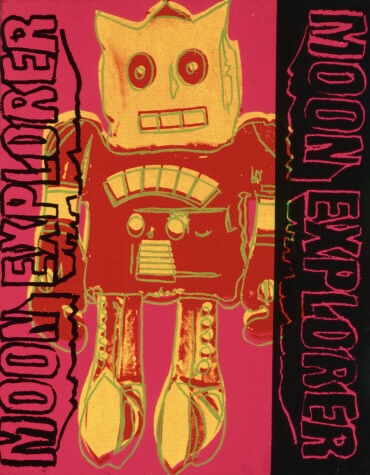
Warhol’s pictures of childhood fantasies and imaginary toys are featured in one area of the show, including his ‘Moon Explorer Robot.’ (© The Andy Warhol Museum)
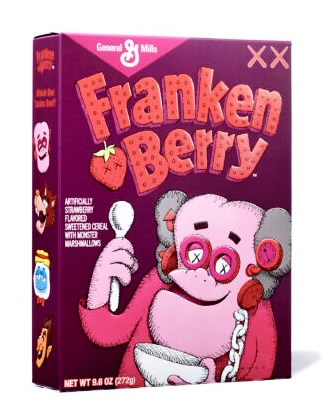
… And just in time for Halloween of 2022, KAWS redesigned limited-edition cereal boxes from General Mills, giving the company’s happy cereal monsters new looks. (© KAWS, photo: Brad Bridgers)
Both men have been scorned for blatantly mining that motherlode of American culture, the market. Various art critics, art purists, and fellow artists have alleged both to be purveyors of simple-minded stuff designed to sell. KAWS in particular evokes the kind of snarky resentment that the artist William Wegman did, some years ago, when he scored a double hit—mass-market success and museum shows—with his cute photographs of dogs dressed up in clothes.
But let us assume we don’t care to argue about what is art versus what is kitsch. Let’s assume we care only about the impact that something has when you see it. I have seen KAWS + Warhol twice, while also observing and talking with other visitors. I would rate the show high on the impact scale.
Death on Wheels and the Mystery of the Blow Job
Moore, the curator, said the two artists are particularly fascinating for “their ability to delight viewers … while exploring dark and serious themes.” Not sure if “delight” is quite the right word, but this generally bright and brassy show contains plenty of dark matter. For example:

This is ‘Gone.’ (© KAWS)
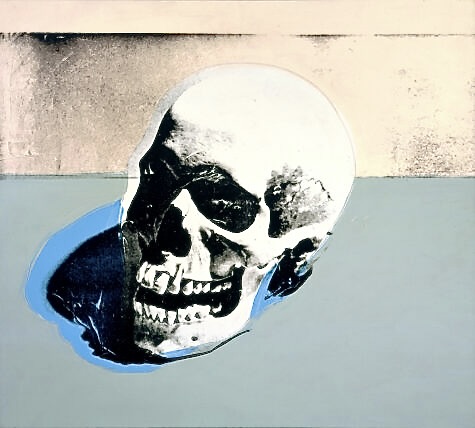
… And Warhol’s acrylic-and-silkscreen ‘Skull’ provides another view of the gone state. Warhol made numerous Skull paintings and prints, most of them around the 1976 date of this picture—several years after he nearly died in a 1968 shooting. (© The Andy Warhol Foundation for the Visual Arts, Inc.)
Also on the dark side are Warhol’s car-crash silkscreens, made from actual news photos taken back in the days before trigger warnings and victim sensitivity, in which mangled people are visible. In KAWS + Warhol, samples of these images are juxtaposed with a KAWS sculpture of his “Companion” figure lying face-down and perhaps dead, and with a garish KAWS painting of a blood-red figure trapped inside bars of a cage.
Another combination in the show could be described as less gruesome and more complex. The Warhol piece is a continuous-loop screening of his 1963 silent film “Blow Job.” The film does not show the act being performed. Rather, it stays tight on the face of actor DeVeren Bookwalter as he receives the benefit of the act. Whether a job is in fact being done to him is questionable; Warhol could’ve easily asked Bookwalter to just fake it. The actor delivers a strange low-key performance, sometimes seeming vaguely pleased and sometimes as if he wished it were over. One KAWS piece nearby is a bold painting of SpongeBob looking shocked. Another is a sculpture of a figure seated with its head buried in its hands. The title of that one is “Separated,” which suggests the creature is mourning a breakup. But to me it felt as if the creature is mourning the entire state of affairs around it—secret doings wrapped in dismay wrapped in goofy artifice. Like the state of the world, maybe. The whole setup struck me as one of the most weirdly intriguing art arrangements I’ve seen.
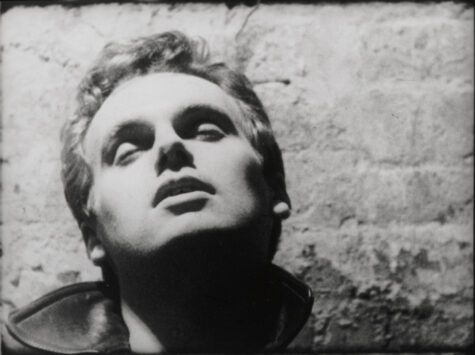
Is the young man ecstatic or wishing he was at a Yankees game? Warhol’s ‘Blow Job’ film leaves the question unresolved. (Still image © The Andy Warhol Museum)
A Ramble Through Rainbows
The show is big, filling the museum’s second floor and part of the fourth. It’s fun to wander around and soak up the auras of various areas, which range from cheerful to grotesque. One wall displays colorful screen prints from Warhol’s “Myths” series. They’re portraits of iconic TV and film characters of the mid-20th century: the beaming puppet Howdy Doody, Margaret Hamilton as the cackling Wicked Witch, etc. Around the corner are KAWS’s modifications of fashion ads: “Untitled (Maidenform)” has an x-eyed KAWS-creature face plastered over the face of a model glamorously sporting a bra.
There’s much more, not all of it super-duper. KAWS has branched into abstract painting, and the abstracts shown here—large ones with splashy bold colors—are OK, not great. But the overall effect of KAWS + Warhol goes ‘way beyond OK. The idea of mixing art by these artists really works. Some of Warhol’s art has the distinctive quality of feeling earnest and yet campy, and many pieces look simple but are laced with layers of intricacies. KAWS’s art tends to feel the other way around: campy and yet earnest. Simple and often repetitive, but the variations in the repetition add up to an intricate swarm. (It helps to see bunches of his pieces together.)
And the colors: At times, as you stroll through the galleries of the show, the patterns of colors used by both create a sensation that’s almost like walking through rainbows. Except that these rainbows are inhabited by images of real and imaginary beings. There are images of things you’ve seen, now seen freshly through the filters of art, and images of things you might dream of seeing or hope you’ll never see.
Previous reviews of the Warhol Museum have called it “a theme park of the mind.” The same goes for this new addition to the park, KAWS + Warhol.
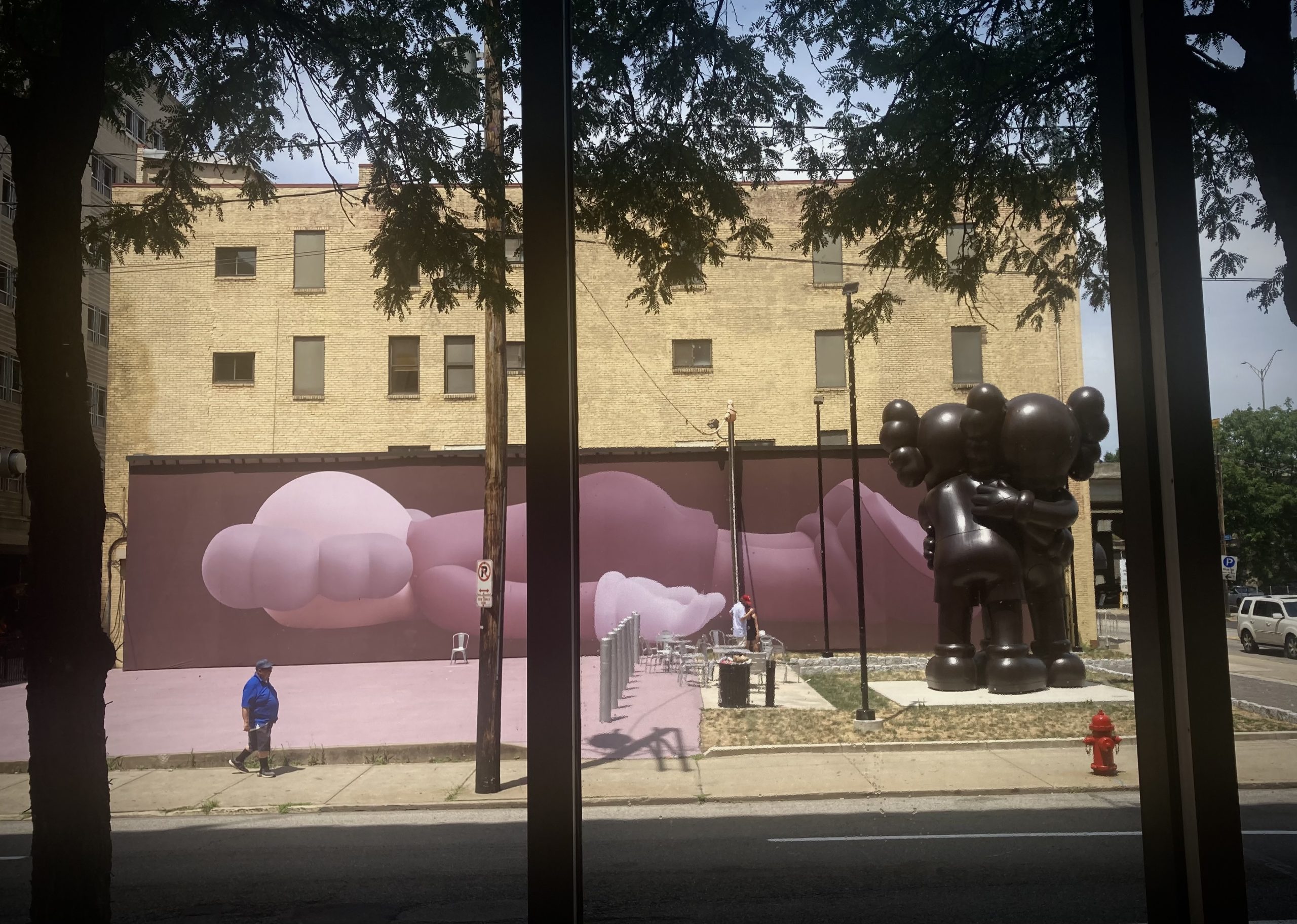
Across the street from The Warhol’s lobby, an immense installation announces the KAWS presence in Pittsburgh. A panorama-sized ‘Companion’ spans the wall of a building behind a towering version of the huggy sculpture ‘Together.’
Credits and Visitor Info
KAWS + Warhol, curated by Patrick Moore, is on view through January 20, 2025 at The Andy Warhol Museum, 117 Sandusky St., North Side. For tickets and other information, visit the page for the show on The Warhol’s website. Please note that the museum is closed on Tuesdays, and open 10 a.m. – 5 p.m. on other days except for Fridays, when the hours extend until 10 p.m. at night.
Also note that The Warhol is part of the Carnegie Museums of Pittsburgh. Instead of paying for a single admission, you might consider buying a membership, which gives you a year’s free access to the Carnegie Museums of Art and Natural History and Carnegie Science Center as well as The Warhol.
Mike Vargo, a Pittsburgh-based freelance writer, covers visual arts and other topics for Entertainment Central.
Share on Social Media
- Like
- Digg
- Del
- Tumblr
- VKontakte
- Buffer
- Love This
- Odnoklassniki
- Meneame
- Blogger
- Amazon
- Yahoo Mail
- Gmail
- AOL
- Newsvine
- HackerNews
- Evernote
- MySpace
- Mail.ru
- Viadeo
- Line
- Comments
- Yummly
- SMS
- Viber
- Telegram
- Subscribe
- Skype
- Facebook Messenger
- Kakao
- LiveJournal
- Yammer
- Edgar
- Fintel
- Mix
- Instapaper
- Copy Link
Follow Entertainment Central
Sign up for the EC Newsletter
Latest Stories



